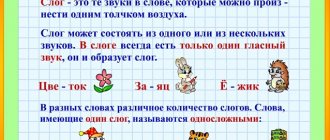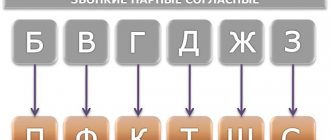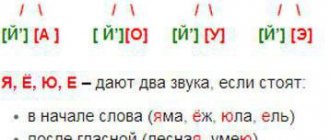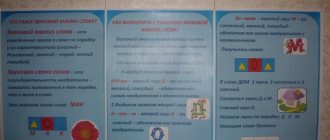What are monosyllabic words
Monosyllabic words are words consisting of one vowel sound and one phonetic syllable. The number of consonants can be any.
A phonetic syllable refers to only one vowel in a word or a vowel in combination with one or more consonant sounds, which, when pronounced, are accompanied by one impulse of exhaled air.
The easiest way to explain to a child what monosyllabic words are is this. Invite him to place his palm under his chin and say, for example, the following words: peace, cheese, mouse, sleep, March, court, sport, look, hedgehog, bread. As you say each of these words, your chin will touch your palm once. This is the defining characteristic of a monosyllabic word.
In other words, such a word has only one stressed syllable - there is simply nowhere else for the stress to fall.
The use of monosyllabic words in written speech is subject to the rule. Such words cannot be transferred from one line to another, because they cannot be divided into syllables.
What is a syllable, what are their types, how to divide words into syllables
So what is this - a syllable?
As you know, every word consists of syllables, which, in turn, consist of letters. However, for a combination of letters to be a syllable, it must contain one vowel, which in itself can form a syllable.
It is generally accepted that a syllable is the smallest pronounceable unit of speech or, more simply, a sound/sound combination pronounced in one exhalation. For example, the word “ya-blo-ko”.
To pronounce it, you need to exhale three times, which means that this word consists of three syllables. In our language, one syllable cannot contain more than one vowel. Therefore, the number of vowels in a word equals the number of syllables. Vowels are syllabic sounds (they create a syllable), while consonants are non-syllabic sounds (they cannot form a syllable).
Syllable theories
There are four theories trying to explain what a syllable is:
- Exhalation theory. One of the most ancient. According to it, the number of syllables in a word is equal to the number of exhalations made when pronouncing it.
- Acoustic theory. It implies that a syllable is a combination of sounds with high and low volume. The vowel is louder, so it is capable of both independently forming a syllable and attracting consonants to itself, like less loud sounds.
- Articulatory theory. In this theory, the syllable is presented as the result of muscle tension, which increases towards the vowel and decreases towards the consonant.
- Dynamic theory. Explains the syllable as a complex phenomenon, which is influenced by a number of factors listed in previous theories.
It is worth noting that each of the above theories has its own disadvantages, as well as advantages, and none of them has been able to fully characterize the nature of the concept “syllable”.
Types of syllables
A word can consist of a different number of syllables - from one or more. It all depends on the vowels, for example: “sleep” - one syllable, “sno-vi-de-ni-e” - five. According to this category, they are divided into monosyllabic and polysyllabic.
If a word contains more than one syllable, then one of them is stressed, and it is called stressed (when pronounced, it is distinguished by the length and strength of its sound), and all the others are unstressed.
Depending on what sound the syllable ends with, they are open (for a vowel) and closed (for a consonant). For example, the word “za-vod”. In this case, the first syllable is open because it ends with the vowel “a,” while the second is closed because it ends with the consonant “d.”
How to correctly separate words into syllables?
First of all, it is worth clarifying that the division of words into phonetic syllables does not always coincide with the division for transfer. So, according to the rules of transfer, one letter cannot be separated, even if it is a vowel and is a syllable.
However, if the word is divided into syllables, according to the rules of division, then a vowel not surrounded by consonants will form one full syllable.
For example: the word “yu-la” phonetically has two syllables, but when transferred, this word will not be separated.
As specified above, a word has exactly as many syllables as vowels. One vowel sound can act as a syllable, but if it contains more than one sound, then such a syllable will necessarily begin with a consonant. The above example - the word "yu-la" - is divided in this way, and not "yul-a". This example demonstrates how the second vowel “a” attracts the “l” to itself.
If there are several consonants in a row in the middle of a word, they belong to the next syllable. This rule applies to cases with the same consonants and to cases with different non-syllable sounds. The word “oh-ch-ya-ny” illustrates both options.
The letter “a” in the second syllable attracted a combination of different consonant letters - “tch”, and “y” - a double “nn”. There is one exception to this rule - for unpaired non-syllable sounds.
If the first in a letter combination is a voiced consonant (y, l, l, m, m, n, n, r', r), then it is separated along with the previous vowel. In the word “sklyanka” the letter “n” belongs to the first syllable, since it is an unpaired voiced consonant.
And in the previous example - “oh-cha-ya-ny” - “n” moved to the beginning of the next syllable, according to the general rule, since it was a paired sonorant.
Sometimes letter combinations of consonants in a letter mean several letters, but sound like one sound. In such cases, dividing the word into syllables and dividing for hyphenation will differ. Since the combination means one sound, these letters should not be separated when dividing them into syllables. However, when transferred, such letter combinations are separated.
For example, the word “i-zzho-ga” has three syllables, but when transferred, this word will be divided as “izzho-ga”. In addition to the letter combination “zzh”, pronounced as one long sound [zh:], this rule also applies to the combinations “tsya” / “tsya”, in which “ts” / “ts” sound like [ts].
For example, it is correct to divide “u-chi-tsya” without breaking “ts”, but when transferring it will be “learn-tsya”.
As noted in the previous section, a syllable can be open or closed. There are significantly fewer closed syllables in the Russian language. As a rule, they are found only at the end of the word: “ha-ker”. In rare cases, closed syllables may appear in the middle of a word, provided that the syllable ends in an unpaired sonorant: “sum-ka”, but “bud-dka”.
How to correctly separate words for hyphenation
Having dealt with the question of what a syllable is, what types there are, and how to divide into them, it is worth turning your attention to the rules of word hyphenation. Indeed, despite their external similarity, these two processes do not always lead to the same result.
When dividing a word for hyphenation, the same principles are used as when dividing it into syllables, but it is worth paying attention to a number of nuances.
It is strictly forbidden to tear off one letter from a word, even if it is a vowel forming a syllable. This prohibition also applies to the transfer of a group of consonants without a vowel, with a soft sign or th. For example, “a-ni-me” is divided into syllables like this, but it can only be transferred in this way: “ani-me”. As a result, when transferred, two syllables appear, although in reality there are three.
If two or more consonants are nearby, they can be divided at your discretion: “te-kstu-ra” or “tek-stu-ra”. When paired consonants are between vowels, they are separated, except when these letters are part of the root at the junction with a suffix or prefix: “class-sy”, but “class-ny”.
The same principle applies to the consonant at the end of the root of a word before a suffix - it is, of course, possible to tear off letters from the root when transferring, but it is not advisable: “Kyiv-skiy”. Similarly, with regard to the prefix: the last consonant included in its composition cannot be torn off: “under-crawl”.
Examples
You can understand what monosyllabic words are based on the examples below. They can consist of one letter. These are the so-called “single-phonemic words”. There are few of them, and the most popular among them, of course, is the personal pronoun “I”. Other examples include the preposition “y”, the conjunctive conjunction “and”, the adversative conjunction “a” and interjections (a, o, e).
A relatively small number of monosyllabic words in the Russian language are represented by two letters. These are prepositions - on, for, in, before, from, by; nouns - as, il, hedgehog, mind, mustache; verb - eats, ate, eats; interjections - uh, oh, oh, ah, uff, fu, fi.
Quite often you can find words in which a vowel letter separates two consonants or is in a different position. Here are examples of three-letter monosyllabic words: without, me, you, two, hundred, cheese, litter, feast, steam, soap, mil, count, rice, tour, boom, zga, etc.
However, linguists claim that the largest number of monosyllabic words are words consisting of more than three letters.
Let us give examples of monosyllabic words consisting of four letters: growth, cheerful, boxing, fast, dispute, friend, frozen, steel, ill, smog, eye, raid, edge, moth, gat, darkness, early, etc.
The number of letters in a word should not be confused with the number of sounds: in the last four examples the number of consonants is two (the soft sign indicates the softness of the previous letter and cannot be considered a sound). You will find similar examples below.
We also remind you that the letter “th” is considered a consonant sound, since it cannot form a syllable.
But here are monosyllabic words with five or more letters: away, guest, steppe, sleeping, suddenly, back, really, glance, filter, Kremlin, passion, steal, etc.
Division by syllables
Syllables are the parts into which a word is divided during oral speech. When we pronounce a word, we get several exhalation pushes of air - this is exactly the pronunciation by syllables: cat. Two pushes of air when exhaling - two syllables: vo-da. 3 puffs of air - three syllables: na-u-ka.
A word has the same number of syllables as there are sounds from the voice, that is, vowels: sheet - 1 syllable, no-ra - 2 syllables. A syllable can have a very different number of letters, but one must be a vowel.
A word can have a different number of syllables. There are one-syllable, two-syllable, three-syllable words and polysyllabic words: leaf (1 syllable), no-ra (two-syllable word), u-e-zhat (three-syllable).
A syllable can consist of one vowel sound or a combination of a vowel and a consonant: a-ba-zhur. Even one vowel sound is already a syllable. But one consonant is not a syllable. How to divide a word into syllables? It is important to understand the main principle: if a syllable includes a vowel and a consonant, then it always begins with a consonant: no-chnik, country.
How to divide a word into syllables with a combination of consonants
How to divide a word into syllables if there are several consonants nearby in the middle? How to correctly break a word into syllables: cat or cat? You need to understand the principle of so-called greater sonority. It is observed in the second case.
Meaning
What does a one-syllable word mean? The complexity of a word is independent of the grammatical, morphological features of words, as well as their lexical meaning
Among the monosyllable words you can find:
- Nouns in the nominative and indirect cases (cheese - nominative case; strength - plural, gender case, darkness - darkness, darkness, etc.).
- Full and short forms of adjectives (angry - angry, rude, white, bald, dashing, etc.).
- Verbs (soaped, chalked, sang, howled, stood up, was, hide, etc.).
- Adverbs (in a big way, to the fullest, in the old days, far away, evil, sorry, in vain, etc.).
- Various pronouns (you, you, he, we, I - me; all, myself; what, how, than; two, three, no, this).
- Particles (at least, well, tea (colloquial), let, after all), as well as the interjections and prepositions already mentioned above.
Two-syllable and other polysyllabic words
According to the number of syllables, words can be, as can be understood from the name, two-syllable, three-syllable, four-syllable, etc.
To clearly explain this point, and to more clearly understand which words are called monosyllabic, you can use the same technique that was described above: when pronouncing two-syllable words, the chin will push the palm twice - as many times as there are syllables in a given word. In other words, there will be two pushes of exhaled air.
Two-syllable words contain two syllables: you-bya, me-nya, stup-pa, snake-ya, palm-don, friendship-ba, te-atr, just, came, shook, alloy, forest, etc.
Here are examples of three- and four-syllable words: tro-pin-ka, petty-ny, kra-si-vy, pro-stu-da, add-ba-vit, u-ka-zat, soar-ki-vat, rainy, zve-rush-ka, out-of-the-year, between-se-zon-e, dance-so-va-ya, ku-ka-re-kat, behind-mi- nat, etc.
Words formed with a suffix or prefix, including those written with a hyphen, are considered as a whole: somehow (two-syllable word), let's go (three-syllable), exactly (two-syllable), come on (two syllables).
Dividing words into syllables
When studying phonetics, schoolchildren starting from the 1st grade not only characterize sounds, but also divide words into syllables. Dividing words into syllables is somewhat difficult, and now we will find out how to complete the task without errors. A syllable is an element of a word that we pronounce in one impulse of air.
Actually difficult words
Please note that in the Russian language there are so-called “compound words” - this is a group of words that contains two or more roots. Most often, these roots are combined into one word using connecting vowels (so-called “interfixes”) or they are written with a hyphen.
In both cases, they should be considered as solid formations, regardless of the number of roots with the help of which they were formed.
Let us give examples of such words: three hundred (two-syllable word, four consonants), airplane (three-syllable word, four consonants), somehow (three-syllable word, three consonants), wardrobe (three-syllable word, five consonants), etc.
Dividing words into syllables
The website slogi.su is the most convenient and fastest service for dividing any Russian words into syllables. The service can highlight syllables both in individual words and in text. We do not have a ready-made dictionary of words with pre-selected syllables; we determine syllables in words automatically.
This means that you can enter a Russian word in any number, gender, case and any other form of declension of the word. In addition to the analysis, we provide information on each highlighted syllable in the word - the type of syllable, the division rule.
The division into syllables on the site is carried out taking into account the modern rules of the Russian language school curriculum (traditional school) and programs with in-depth study. If there is a difference in the syllable division of the two programs, explanations are given on the word page.
If you need to break all the words in the text into syllables, use the form below. Using the form, it is convenient to bring the text of a song into karaoke format, prepare a children's story for reading syllable by syllable, break words into syllables for foreigners and for other useful needs.
Syllable
A syllable is the smallest complete pronounceable unit in spoken language. Syllables are formed only by vowel sounds, so the number of syllables is equal to the number of vowels in a word.
Consonants “adjoin” one or another vowel in accordance with the rules of division into syllables that developed during the development of the Russian language. The syllable division rules describe the correct ways to parse words into syllables.
Syllables are: open and closed, covered and uncovered. An open syllable ends with a vowel, a closed syllable ends with a consonant. A covered syllable begins with a consonant, and an uncovered syllable begins with a vowel.
Syllable emphasis
Below we describe general approaches to highlighting syllables in words for the traditional school and with in-depth study. For detailed materials with explanations and examples, see the rules page for dividing words into syllables.
Traditional school
The main rule of the regular school curriculum, which the child is guided by: as many vowels, as many syllables. When translating words, they are guided by the rules: we transfer the word by syllables, you cannot leave one letter on a line. Everyone knows these rules.
When dividing a word into syllables, you can use the push method: we place our palm to our mouth and feel the push of air as we pronounce the word. Or we imagine a candle in front of us: the number of times the flame flickers, the number of syllables. For some words with flowing consonants, this option is not always suitable.
The principles of teaching division into syllables vary in different primary schools. In some schools, they are taught to visually divide a word into parts - vowel + consonant connectives (or vowel + several consonants). Other schools teach how to pronounce a word with pauses in a convenient way. Pauses create places for dividing syllables.
School of Advanced Study
In schools for in-depth study of the Russian language and in institute programs, cases are dealt with when words are not transferred into syllables, that is, the syllable of transfer does not coincide with the phonetic syllable.
The division of a word into syllables occurs in such a way that the syllable is pronounced in increasing order: from voiceless pronunciation to voiced pronunciation. Therefore, syllables consisting of several sounds always begin with a voiceless consonant and end with a vowel. For example: by mail (but not by mail), mo-shka (but not by mosh-ka).
A syllable can end with a voiced consonant (sonorant r, l, m, n), which sounds less sonorous than a vowel, but louder than a voiceless consonant. For example: bun, cook.
Source: https://slogi.su/





